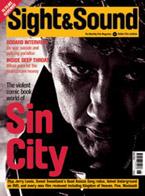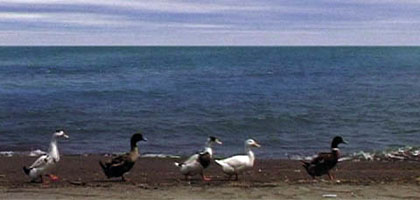
Five
Japan/Iran 2004

Reviewed by Jonathan Romney
Synopsis
Our synopses give away the plot in full, including surprise twists.
Five wordless vignettes. 1. A piece of wood is tossed by waves; a piece breaks off. 2. People walk by on a seafront promenade; four old men stop to talk. 3. A group of dogs sit on a beach; the sun grows brighter. 4. A flock of ducks cross a beach from left to right, then back the other way. 5. Moonlight is reflected on the surface of a pond. Frogs croak, dogs bark, a storm breaks and passes. Cocks crow as the day breaks.
Review
Abbas Kiarostami's in-car drama 10 (2002) was about as simple as narrative cinema could get: two characters in each episode, filmed by a DV camera mounted on the car dashboard. His follow-up Five, the very title suggestive of further reduction, is an even more defiant rejection of the conventional superfluities of cinema, jettisoning both the spoken word and - apparently - any residue of narrative. Subtitled '5 Long Takes Dedicated to Yasujiro Ozu', the film comprises five single shots, seemingly no more than compositions that caught the film-maker's eye while staying in Northern Iran on the shores of the Caspian Sea, and close in spirit to Kiarostami's still photographs and _haiku-like poems. Although it is being commercially screened in cinemas - and was premiered out of competition in Cannes last year - Five has less in common with art film, even at its least narrative, than with gallery video, another form the director has explored.
Kiarostami has described Five as representing a process in which "the author disappears; there is no longer a director". He had already hypothesised his own disappearance when discussing 10, in which the performers are effectively left on their own, and to their own devices. Much of the directing, in other words, goes on before they get in the car, but it still goes on; all Kiarostami means, surely, is that the director is not physically present during the shooting. In Five, however, the director clearly is present, and handling the DV camera himself: he is simply detaching himself in a new way, presenting himself as an observer rather than a manipulator of the action. Yet his claims to non-intervention arouse suspicion, for the action in Five - such as it is - is far more manipulated than is immediately apparent. For one thing, Kiarostami makes editorial choices about the length of each vignette, about where and when to start each shot, and about the framing which, in at least three episodes, is self-consciously formal.
In the first, seemingly most happenstance segment, the handheld camera follows the movement of a small log as waves roll it on and off a beach. Then something occurs that must clearly qualify as a narrative moment: a small chunk falls off the log. This fragment remains on the beach while the log is carried off to sea, disappearing from view. Before the episode ends, the log reappears, tantalisingly bobbing near the top of the screen, then is lost to view again. The episode ends with a piece of the music - poignant, dramatic, unashamedly rhetorical - with which Kiarostami punctuates his episodes.
The log vignette could be read as a micro-parable of togetherness and separation: by the end, we're sorry to see the original chunk of wood vanish. It could seem absurd to read such meaning into an event so banal: yet that is precisely what Kiarostami encourages us to do in these episodes, and that, surely, is one definition of the poetic urge.
Credits
- Director
- Abbas Kiarostami
- Production Companies
- An NHK production Hermes Records Co., Behnegar Co., 7th View Art Studio
